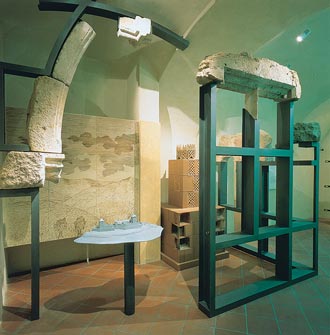Permanent Display 7. Medvedgrad
 The fortified Medvedgrad Castle was built at the instigation of Pope Innocent IV in the mid-thirteenth century to ward off Tatar invasions – the traces of their devastating incursion in 1242 were still all too fresh. Perched on the highest peak of the southern foothills of Medvednica Mountain, Medvedgrad had a good position from which its occupants could keep watch on the area stretching from Medvednica in the north to Turopolje in the south, and on the route which could be used for a strike from the plains of Slavonia westward; the route along the Sava valley was protected by Susedgrad. It was the time of the episcopate of Bishop Filip (1247-1262), an ally of King Bela IV, who gave his support to the construction of Medvedgrad. The castle, completed in 1254, was surrounded by double walls and a moat and had two towers, a residential palace, a chapel and a cistern, thus providing defence and domesticity.
The fortified Medvedgrad Castle was built at the instigation of Pope Innocent IV in the mid-thirteenth century to ward off Tatar invasions – the traces of their devastating incursion in 1242 were still all too fresh. Perched on the highest peak of the southern foothills of Medvednica Mountain, Medvedgrad had a good position from which its occupants could keep watch on the area stretching from Medvednica in the north to Turopolje in the south, and on the route which could be used for a strike from the plains of Slavonia westward; the route along the Sava valley was protected by Susedgrad. It was the time of the episcopate of Bishop Filip (1247-1262), an ally of King Bela IV, who gave his support to the construction of Medvedgrad. The castle, completed in 1254, was surrounded by double walls and a moat and had two towers, a residential palace, a chapel and a cistern, thus providing defence and domesticity.
The architecture of many parts of Medvedgrad, especially the recently restored octagonal chapel of St. Philip and St. James, are considered the finest early Gothic buildings in Croatia.
Medvedgrad changed many masters – from Croatian-Hungarian kings and bishops of Zagreb to noblemen and canons. Among them were Duke Koloman, the Babonić family, Ban Mikac, King Sigismund, the counts of Celje, King Matthias Corvinus, Duke Janos Corvinus, George of Brandenburg and Nikola Zrinski. Its last residents were the Gregorijanec, who left the castle in 1571 and moved to their new manor-house at Šestine.
.jpg)
The powerful earthquake that hit the area on 15th September 1590 destroyed Medvedgrad. What life was like in Medvedgrad has been revealed by recent archeological excavations (1987-1994). Careful conservation and restoration work has given the monument a new lease of life. In front of the south wall of the fortress a monument has been erected to all heroes of Croatia – the Altar of the Fatherland, the work of the sculptor Kuzma Kovačić.
Boris Mašić

